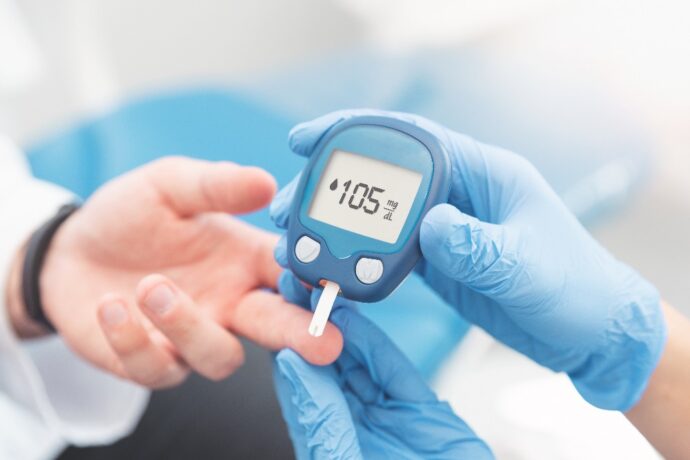Our body needs vitamins and minerals to stay up and function all day every day without any break or rest in between. However, anything more than the threshold limit is dangerous. Excess minerals like iron and zinc can cause health complications like fatigue, hyperpigmentation, and abdominal pain. Similarly, sugar levels in our blood need to be under control to avoid serious consequences.
In this article, we walk you through what glucose levels are, symptoms of high levels, diagnosis, and much more.
What is Glucose in Blood?

Blood glucose levels represent the sugar found in your blood. This glucose comes from the food you eat and is your body’s main source of energy. Your blood carries glucose to all of your body’s cells to use for energy. Diabetes is a disease in which your blood sugar levels are too high and your body has failed or failed to regulate.
Glucose levels are controlled by a hormone called insulin. Insulin is secreted by the and they act like a regulator of insulin. There are various factors that can contribute to becoming a diabetic or at pre-diabetic levels, most of them are lifestyle activities such as –
- Obese/overweight
- High blood pressure
- Family history of having diabetes/heart disease
- Physically inactive
The Centers for Disease Control and Prevention (CDC) says that more than 34 million people in the United States have diabetes and every 1 in 4 of those people do not know they have diabetes. Not to mention, diabetes is ranked as the seventh leading cause of death in the US.
Symptoms of Abnormal Glucose levels

Multiple symptoms indicate your sugar levels are through the roof. When you see such symptoms your physician will order a Hemoglobin A1c test which measures the average level of your sugar levels in the past 90 days. The measurement is taken for the last 90 days because the red blood cells that transport oxygen lives for 3 months before new cells generate.
This A1c test is regularly done in diabetic patients to monitor the sugar levels once in a while. This test also checks for pre-diabetes levels when the blood sugar levels show that you are at risk of getting diabetes.
If you were healthy but starting to notice symptoms suddenly, then get checked for Hemoglobin A1c levels to assess your sugar levels. The quicker you diagnose, the better chances you can avoid becoming a diabetic life-long.
3 Signs of Diabetic levels
1. Increased thirst

Excessive thirst is one of the first signs that you can encounter. More than the required amount of sugar levels in blood causes the levels to need of water quite often. Both pre-diabetic conditions and diabetic levels have increased thirst symptoms.
2. Frequent urination
As a result of increased thirst, we drink more water, which results in frequent urination. To get rid of the excess sugar circulating in your blood, your body uses additional water to flush out the surplus glucose. Frequent urination is often identified as a symptom of diabetics.
3. Fatigue

Fatigue and feeling hungry frequently are some of the other common symptoms of high sugar levels.
In a healthy adult, the normal A1C levels should range between 4% and 5.6%. In the case of prediabetes, your levels range between 5.7% and 6.4%, If the glucose levels are higher than 6.5%, it indicates that you have diabetes, that is your insulin production is either insufficient or your body is not able to utilize the produced insulin effectively.
How to Treat Abnormal Diabetic Levels?

If you experience any of the above symptoms, then get checked for Hemoglobin A1c levels as early as possible. Diagnostics testing providers like DxSaver.com can help you find the best lab in your vicinity and along with their prices. Once diagnosed with glucose levels, your physician will prescribe medications according to your report.
There is no complete cure for diabetes yet, however, the levels can be controlled and ensured that it won’t affect any other organs or cause any other further complication.
If high levels are left untreated, it can lead to the following health complications –
Urinary tract infection
Due to excess sugar in the blood, your kidney overloads itself and tries to excrete the glucose in urine. Due to frequent urination, some people can encounter Urinary Tract Infection infection in the genitals and urinary tract, however, this is not a serious issue unless you bring down the excess sugar levels. If not addressed at an early stage, then UTI can lead to kidney disease, which comes to our next point.
Kidney disease
Due to more sugar content in blood, purifying the blood is not easy for your kidneys. Kidneys get ruptured quickly and fail to function in some cases, resulting in surgery for kidney removal.
Foot problems
Changes in skin color of your foot, and swelling in the foot more particularly around the ankle is a sign that shouldn’t be taken lightly. Changes in skin temperature and pain in the legs can also be experienced.
Apart from the above three conditions, you can also encounter erectile dysfunction, heart disease, and diabetic eye disease like diabetic retinopathy which is a condition where too many sugar levels damage your retina. Diabetes deteriorates the blood vessels throughout the body.
Conclusion
Limiting sugar intake and having a balanced diet with nutritious foods can help you stay away from the life-long disease. It all starts from the food intake, the better we eat, the healthier our life is. It is highly recommended that maintaining a good lifestyle, avoiding alcohol and tobacco, and working out every day for at least 20 minutes can keep you miles ahead in health and wealth.















